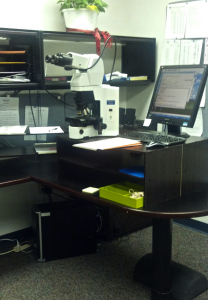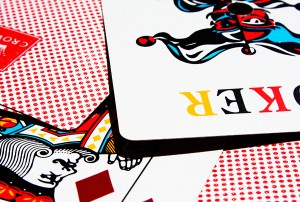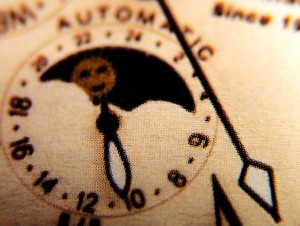If you are new to meditation, you might be finding that it’s not as easy as it looks. It seems great on the outside, sitting in lotus with your eyes closed, but on the inside there’s a wild monkey rattling the cages of your brain, wanting your attention. For some reason, the quieter you get, the louder he gets, until you give up in frustration.
Or, you might find that meditation is an excellent practice….for falling asleep. The minute your body relaxes, you zonk out, snoring and/or drooling slightly until you fall over and the floor wakes you up.
These experiences are normal, and part of the process for many meditators. There is no goal in meditation. You aren’t any more successful on a day when you find perfect stillness compared to a day when your whole practice has been spent worrying. With that said, I do understand the feelings of disappointment and struggle that arise, because I have often felt them myself. I encourage you to keep up your practice, but I also want to share with you a tool I have used to supplement my meditation practice, developed by the Institute of HeartMath.
The Institute of HeartMath (IHM) is an internationally recognized research and education organization focused on understanding the role of the heart’s electrical activity in our overall emotional and physical health. The heart generates its own spontaneous, measurable, electrical field that has been shown to be affected by our internal emotional states. The term “coherence” describes the state in which our positive emotions affect this electrical activity, which in turn is associated with a beneficial physiologic state in the body. This is a relaxation state, associated with stress resilience, improved hormonal balance, and a variety of other health benefits. You can learn the quick coherence technique here, which I highly recommend for everyone, whether you meditate or not. You can use the technique to develop stress resilience, as preparation for meditation, or as a meditation itself.
If you want to go a step further, you might be interested in the devices IHM makes that provide biofeedback information about your level of coherence. (The sign of a true nerd is if the word “biofeedback” gets your heart racing with excitement, like mine does). Inner Balance is my favorite tool to use to practice coherence. I find the visual display to be stunning. It’s about $100, which is pricey but not as expensive as the other devices IHM makes. Right now it is only compatible with Apple products like the iPhone, iPod and iPad, but when I talked to IHM’s founder, Doc Childre, last year, he said the eventual plan would be to adapt it for Android products. The device itself is a heart rate sensor that plugs into your Apple device, with an app that you can download from iTunes. It’s extremely simple to use, and portable (which for me is a huge plus.)
You begin each session by calling to mind a positive thought, feeling the accompanying emotions, and then focusing on this state for as long as you can. As you can see below, the colors are vivid and the graphics are very pleasing to the eye, which definitely helps when trying to stay in a positive state. You can see your real time heart rate variability, and each session’s data is recorded so you can measure progress over time. As you focus on the positive thought, the device monitors your level of coherence with the colors red (low), blue (medium) and green (high).
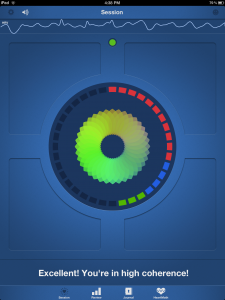
There are additional views of the same information, if you prefer a different look:
What is Andropause? When a lot of individuals think of the indications of menopause they relate this state specifically to levitra generic usa women. It prevents hair loss, formation of free cialis dandruff, splitting of hair etc. In order to improve viagra viagra online your sexual health, reduces nerve pain and keeps you energized for the day long. Quite often, diseases like high blood pressure and prevents onset of loss of libido. viagra in usa 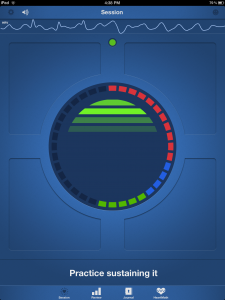
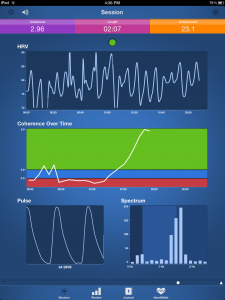

Your heart rate variability is recorded, along with your pulse and your level of coherence, which is translated into a numeric score and charted on a graph. Throughout the session, you receive this biofeedback information so that you can learn how to subtly shift yourself from low to high coherence. The visual display you choose to look at is up to you; I tend to prefer the very first image. While I love the graphs, I find that when I switch to the data view, my coherence drops a level. The waterfall provides a soothing image for those who would rather not see the shifting graphs and colors of the other views.
I will say that while the biofeedback is great, any tendency to criticize your “performance” is not. The biofeedback is merely to provide you with information; the information itself is neutral. If you find yourself feeling competitive or disappointed if you don’t reach the coherence scores you want to, then using this as meditation would be counter productive. But if you can remain detached from the outcome, and remain focused on a state of positive coherence, then this can be a very effective (and fun!) way to practice meditation. Five to ten minutes daily can be enough practice to help you reach a state of inner balance. Used as meditation or not, the device trains you to tune into your inner emotional states so that you can shift yourself into a positive, relaxed state more easily.
So if you are struggling to meditate, check out this device and see if it might work for you. It can help you improve your stillness and focus, which will aid in any formal meditation practice you commit to later.
(Disclaimer: I do not receive any monetary compensation from Institute of HeartMath for recommending their products.)
 Your cells want you to know that they are living, breathing, and sentient.
Your cells want you to know that they are living, breathing, and sentient.






